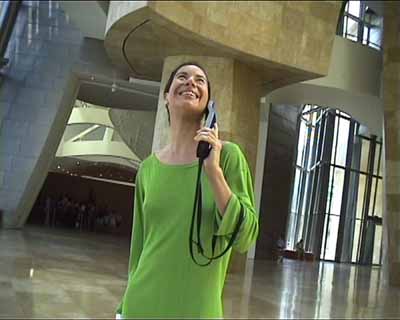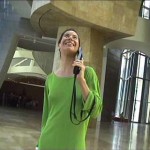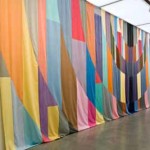By JAMES NADEAU
"The spectacle cannot be understood either as a deliberate distortion of the visual world or as a product of the technology of the mass dissemination of images."
- Guy Debord
It is tempting when entering the new ICA to ignore the art and simply bask in the presence of its architecture. If fact, entering the building becomes a work of art itself as the austerity of the building and its surroundings lead one to believe that you have left Boston and have entered a whole new realm of angles and mathematical equations. Visiting the new ICA is a performance piece. You "act out" the role of art spectator. You have to want to go there because God knows it is not simple to get to. There is no way to "happen upon" it. I might seem to be digressing here, as this is presumably a critique of the current exhibition "The World as a Stage" but I am not. The premise of the exhibition is for artists to "reinterpret traditional notions of spectacle, performance, and the gallery space." Isn't this what the architecture of the new ICA attempts to do? The building itself is an exercise in spectacle, one has to perform the role of art spectator to get there and presumably Diller Scofidio + Renfro with Perry Dean Rogers Partners (the architects) were called upon to rethink the concept of the gallery space when chosen to design the building. It would seem that this is really quite a perfect show to be brought to this museum. Alas, it is and it isn't.
The show purports to be about "how a sense of theater or spectacle has had an impact on the museum experience, redefining the roles of spectator and participant." An intriguing idea that somehow falls conceptually flat. The notion that theatre and spectacle have impacted the museum experience seems awfully dated in a world where our experiences with art (both in and out of the museum context) have becoming more and more visceral and interactive. Perhaps this is because our cultural experiences with theatre have become even more removed than ever before. Theatre is now something that rarely affects us on a day-to-day basis. Of course, the show did not originate here. It was originally installed at the Tate Modern last fall. It is safe to say that the show has more to do with the British relationship to theatre than our own.
I found it really intriguing to see Ulla von Brandenburd's "Curtain" hanging across the gallery space with no visual signifiers regarding its nature as a stage curtain aside from the name. Its spatial relationship with Rita McBride's "Arena" comes across as haphazard at best. I couldn't help but think of missed opportunities here with two such grandiose references to theatrical experiences seemingly plonked down in the gallery space. The two pieces themselves are unfortunately so bland and banal that without any discourse between them (other then "one is here and the other over there") they are simply in the way. At this point it is best to move on to the other works that occupy the main gallery space with them. Germany's Jeppe Hein's "Rotating Labyrinth" sits at the center of McBrides' "Arena" space. Hein's rotating circle of mirrored bars provides a nice counterpoint to "Arena." The play between these two works quite well when thinking of the anxieties provoked by watching and being watched.
Two installation pieces offered up interesting takes on the notion of the interactive or theatrical spaces in museums. Dominique Gonzalez-Foerster's "Seance du Shadow II" came across as interesting conceptually but in realization feel flat. One side of a darkened gallery is painted blue while along the other sit several bright lights at floor level. When you enter the gallery you trigger each lamp throwing your shadow across the gallery space and onto the blue wall. For me it evoked thoughts of Plato's cave and the notion that what we see and experience are just shadows on a wall. It is probably the closest one can get to the conceptual groundings of this show yet perhaps in its simplicity this grand concept gets lost. Could this be due to the fact that for most of us, in our day-to-day experiences, practically everything around us is automated? Gonzalez-Foerster's piece then reads more as an "automated" installation and less of a comment on our lives and experiences. In contrast to Gonzalez-Foerster's simplicity Mario Ybarra, Jr., "Sweeney Tate" practically jumped out of the gallery and beat you over the head. It is a fun and somewhat anarchic recreation of a barbershop in the artist's hometown of Los Angeles. The artists actually invited local barbers to compete in a one-day competition when it was installed at the Tate Modern. I can imagine that this act truly transforms the piece but as a stand-alone installation it is unfortunately all style and no substance.
There were really only two pieces in the exhibition that I felt were truly outstanding: Andrea Fraser's "Little Frank and His Carp" and Jeremy Deller's "The Battle of Orgreave Archive (An Injury to One is an Injury to All)." Fraser's video "Little Frank and His Carp" is a work that I have loved for years (it was made in 2001). It is a hilarious send up of museums, museumgoers and institutional self-love. Through the simple act of having herself videotaped navigating the Balboa Guggenheim while listening to the museum's audio tour Fraser critiques practically all aspects of contemporary museum culture. The irony of its placement alongside the grand window walk of the ICA's galleries was a nice touch as well. Deller's "The Battle of Orgreave Archive (An Injury to One is an Injury to All)" is a tour de force. It is a stellar examination of cultural history, memory and the human desire to recreate and relive experiences. Deller delves into the violent history of the British miner's strike of 1984. His meticulous research is displayed throughout the gallery bringing you into a moment that very few Americans are aware of. This is capped by a video documenting his re-enactment of the violent clash between the police and striking miners played out by many of the original participants. It is a phenomenal piece that scrutinizes capitalism, politics and memory.
Ultimately "The World as a Stage" brings together an interesting group of artists touching on a topic that, while intriguing, cannot help but seem dated and a little boring. Is this due to its origins in a country and a culture with a stronger connection to the theater? Experiencing this show at the Tate was undoubtedly different that experiencing it here. But I wonder about the choices made in bringing the show to the ICA. It is interesting to think of this show being "staged" in a state that banned theatrical productions for much of its history. But it seems disingenuous to have an exhibition that promises to "reinterpret traditional notions of spectacle, performance, and the gallery space" in a city that has such a strong community of performance artists. It delineates between theatre and "performance" in a way that just seems intellectually sloppy. Overall the show doesn't read as "bad." As I said, it includes some interesting artists and a couple of good pieces but in the end I wanted (and expected) better. The building and this town deserve more. I'd like to see the ICA live up to its potential and challenge Boston audiences with its shows not put us to sleep with banal offerings like this one.
- Andrea Fraser, Little Frank and His Carp, 2001.
- Mario Ybarra, Jr., Sweeney Tate, 2007.
- Ulla von Brandenburg, Curtain, 2007.
"The World As A Stage" is on view February 1 - April 27, 2008 at the ICA.
All images are courtesy of the Institute of Contemporary Art.







